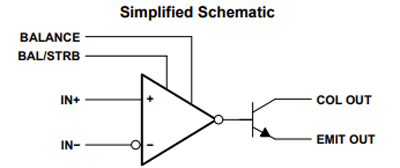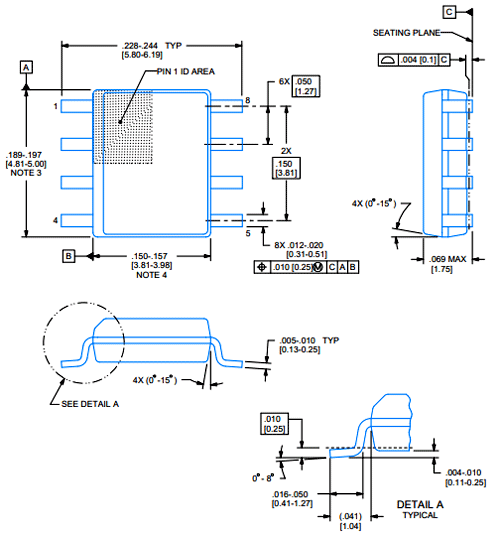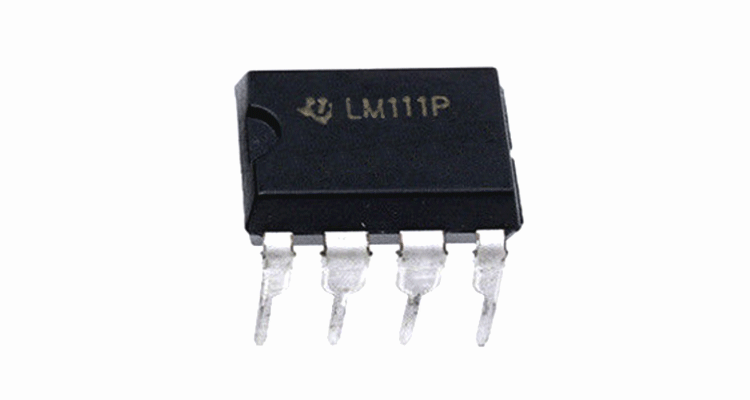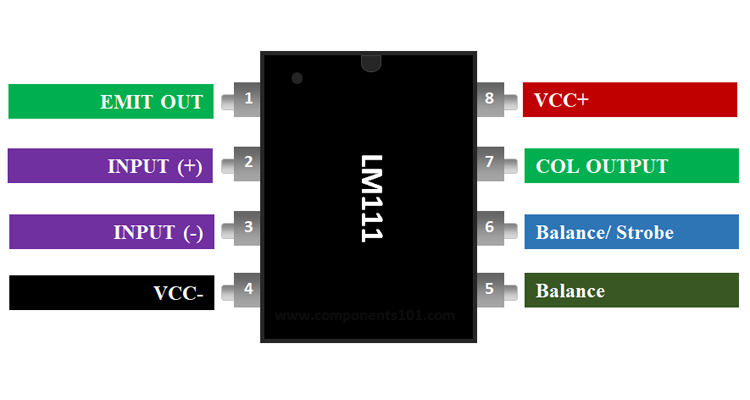LM111 Differential Comparator
The LM111 is a single high-speed voltage comparator. These devices are designed to operate from a wide range of power supply voltages, including ±15-V supplies for operational amplifiers and 5-V supplies for logic systems.
Pin Description of LM111
|
Pin Number |
Pin Name |
Description |
|
1 |
EMIT OUT |
Output Emitter Comparator |
|
2 |
Non-Inverting Input (IN+) |
The Non-Inverting Pin of the comparator gives a variable voltage to compare |
|
3 |
Inverting Input (IN-) |
The Inverting pin is also given a fixed voltage which is compared with the (IN+) |
|
4 |
Ground (VCC-) |
Ground pin connected to the case |
|
5 |
Balance |
This pin can be used to turn off the DC-offset voltage |
|
6 |
Balance/Strobe |
This pin can be used to turn off the output stage |
|
7 |
COL OUTPUT |
Output Collector Comparator |
|
8 |
VCC+ |
Provide the operating voltage for the Op-Amp. For LT111 it is up to +15V |
LM111 features and specifications
- Max Input Voltage (VI) : ±15V
- Maximum Input Bias Current: 300nA
- Differential input voltage (VID) : ±30
- Maximum Input Offset Current: 70nA
- Max Response Time: 165nS
- Min. Voltage Gain: 200,000
- ±30V Differential Input Voltage
- Drives 50mA Loads At Up To 50V.
Note: Complete Technical Details can be found at the LM111 datasheet given at the end of this page.
Equivalent for LM111: LM211, LM311
Alternatives Comparator Op-Amp IC: LM741, LM358, LM339, LM324
Where to use the LM111 Comparator Op-Amp:
The LM111 Differential Comparator Op-Amp is a very popular comparator IC from Texas Instruments that have been used for Voltage comparisons for a long time in electronic designs. Any Op-Amp can be made to work as a voltage comparator, but the LM111 proves itself to be advantaged by housing an Output Transistor inside its package. The collector and Emitter pin of this Transistor can also be controlled by the hardware, this makes it’s suitable for many applications. The simplified schematics of the IC is shown below

This transistor has can drive loads up to 50V and 50mA which is suitable for driving most of the TTL, MOS and RTL loads. The transistor can also make the Load to be isolated from the system ground. So if you are looking for a Voltage comparator to drive loads of these specifications then this IC might be the right choice for you.
How to use LM111:
Like all voltage Comparators, the LM111 also has an Inverting Pin and a Non-Inverting Pin. If the voltage at the Non-Inverting Terminal (pin 2) is high than the Inverting Terminal (pin 2) the output (pin 7) will also be high else the output will be low.
The LM311 can work in a Single supply voltage or dual supply mode. For now, let’s concentrate on the +5V supply voltage circuit since this is the most used design for digital circuits. In this type, the VCC+ (pin 8) is connected to +5V supply voltage and the VCC- (pin 4) is grounded to hold it at 0V potential. A sample circuit is shown below in which the Inverting Terminal is set to 2.5V and the Non-Inverting Terminal voltage is varied using a potentiometer. You can note that the Output voltage stays high when pin 2 has a higher voltage than pin 7 and vice versa.

The pins 5 and 6 on the Op-amp are used to set the balance voltage if you want to manually adjust the DC-Offset voltage. Normally these pins are not used since the Input Offset itself is much better controlled. When not in use the pins 5 and 6 should be shorted as shown above. You can also notice that the Collector pin (pin 7) of the transistor is used for output and the emitter pin (pin 1) is grounded this type of design is called “Collector output Circuit.”
Applications of LM111:
- Voltage Comparator circuits
- Can drive Relay, Lamp, Motor Etc.
- Zero-Crossing detector
- Peak voltage Detector
- High Voltage protection/Warning
- Oscillator circuits
2D-Model of LM111:
Dimensions for LM111 is given below. These dimensions are for the SOIC package.











